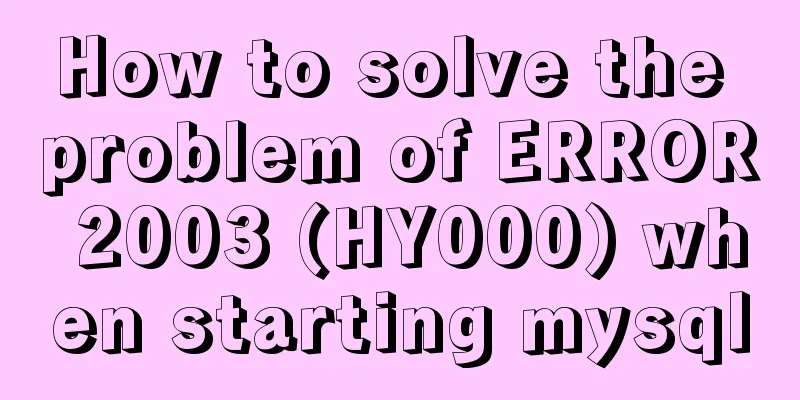Detailed explanation of the implementation principle of Vue2.0/3.0 two-way data binding

The implementation principle of Vue2.0/3.0 two-way data bindingTwo-way data binding simply means that changes in data can cause the page to re-render The principle of Vue2.0 ES5: Object.defineProperty intercepts data Simple small case
<body>
Name:
<span id="name"></span>
<br />
<input type="text" id="inputName" />
</body>
Changing the value of the input box changes the value in the span accordingly. The change in data can make the view
<script>
let obj = {
name:''
}
Object.defineProperty(obj,'name',{
get(){
return this.name //Note that the error demonstration cannot use this to form an infinite loop and a new value must be prepared},
set(val){
}
})
</script>
Correct writing
<script>
let obj = {
name: ""
};
let newObj = JSON.parse(JSON.stringify(obj));
Object.defineProperty(obj, "name", {
get() {
return newObj.name;
},
set(val) {
if (val === newObj.name) return; // Increase the judgment to optimize performance. If the new value is the same as the old value, return it. If it is different, re-assign the value newObj.name = val;
obServer();
}
});
// Re-assignment method function obServer() {
spanName.innerHTML = newObj.name; //Get the value of obj.name inputName.value = newObj.name;
}
obServer(); //Execute once at the beginning setTimeout(() => {
obj.name = "大左";
}, 1000);
</script>
Execution Logic 1. setTimeout executes 1 second later and modifies the data to trigger obj.name's set (val) 2. Get the latest value and give it to newObj.name to execute the obServer() method 3. Get the latest value and assign spanName.innerHTML = newObj.name; inputName.value = newObj.name;
The value of the input box changes and the value of the span box changes accordingly
inputName.oninput = function() {
obj.name = this.value;
};
This operation is called v-model in Vue Vue 2.0 shortcomings1. The original data needs to be cloned, otherwise the infinite loop is mentioned above 2. If we want to intercept get and set of data in an object, we need to set the attributes in the object one by one and listen to them separately. If there are multiple attributes, we need to loop through them and listen to them separately. Reverse look at the data in vue2.0
data(){
return {
obj:{}
}
}
this.obj.name='XXX' //This operation does not work because there is no name in obj at the beginning, so no monitoring is performed. This is caused by the second item aboveOK, let's take a look at it again. Features and benefits of 3.0Mainly used the proxy in SE6
<script>
let obj = {};
obj = new Proxy(obj, {
get(target, prop) {
console.log("D");
return target[prop];
},
set(target, prop, value) {
console.log("Z");
target[prop] = value;
}
}); //Monitoring the entire object does not require specifying attributes, which is equivalent to monitoring all attributes in the object. So just write the overall set get
</script>
1. Get obj.name to trigger get. There is no name here, but it can go because there is no value, so it returns undefine.
2. Set the name value to see the trigger set
3. Get obj.name again to see if there is a value
So no matter whether you have a certain attribute in the object now, because what is monitored here is the entire object, all the future ones in the object will make up for the shortcomings of 2.0 1. No need to clone 2. There is no need to set the properties of each object separately. Just set them for the entire object. It is clean and hygienic. Implement the above 2.0 operation again
<script>
let obj = {};
obj = new Proxy(obj, {
get(target, prop) {
console.log("D");
return target[prop];
},
set(target, prop, value) {
console.log("Z");
target[prop] = value;
obServer();
}
}); //Monitoring the entire object does not require specifying attributes, which is equivalent to monitoring all attributes in the object. So just write the overall set get
// Re-assignment method function obServer() {
spanName.innerHTML = obj.name; //Get the value of obj.name inputName.value = obj.name;
}
obServer(); //Execute once at the beginning setTimeout(() => {
obj.name = "大左";
}, 1000);
inputName.oninput = function() {
obj.name = this.value;
};
</script>
SummarizeThis is the end of this article about the implementation principle of Vue2.0/3.0 two-way data binding. For more relevant Vue two-way data binding principle content, please search 123WORDPRESS.COM's previous articles or continue to browse the following related articles. I hope everyone will support 123WORDPRESS.COM in the future! You may also be interested in:
|
<<: The simplest MySQL data backup and restore tutorial in history (Part 2) (Part 36)
>>: How to quickly deploy an Elasticsearch cluster using docker
Recommend
Summary of knowledge points about covering index in MySQL
If an index contains (or covers) the values of ...
Design of pop-up windows and floating layers in web design
In the trend of gradual transition from tradition...
CSS method of clearing float and BFC
BFC BFC: Block Formatting Context BFC layout rule...
mysql settings to change the root password, mysql server connection, mysql common commands diagram
1. Set and change the root password Check whether...
Instructions for using MySQL isolation Read View
Which historical version can the current transact...
Analysis of the underlying principle of MySQL multi-version concurrency control MVCC
Table of contents 1 Problems encountered in trans...
Detailed explanation of nginx request header data reading process
In the previous article, we explained how nginx r...
Detailed explanation of MySQL basic operations (Part 2)
Preface This article contains 1. Several major co...
Analysis on the problem of data loss caused by forced refresh of vuex
vuex-persistedstate Core principle: store all vue...
Example of implementing skeleton screen with Vue
Table of contents Skeleton screen use Vue archite...
How to set up FTP server in CentOS7
FTP is mainly used for file transfer, and is gene...
In-depth explanation of the impact of NULL on indexes in MySQL
Preface I have read many blogs and heard many peo...
Several ways to solve the problem of floating causing the height of the parent element to collapse in CSS
In the past, float was often used for layout, but...
Install Docker for Windows on Windows 10 Home Edition
0. Background Hardware: Xiaomi Notebook Air 13/In...
The difference between ENTRYPOINT and CMD in Dockerfile
In the Docker system learning tutorial, we learne...















